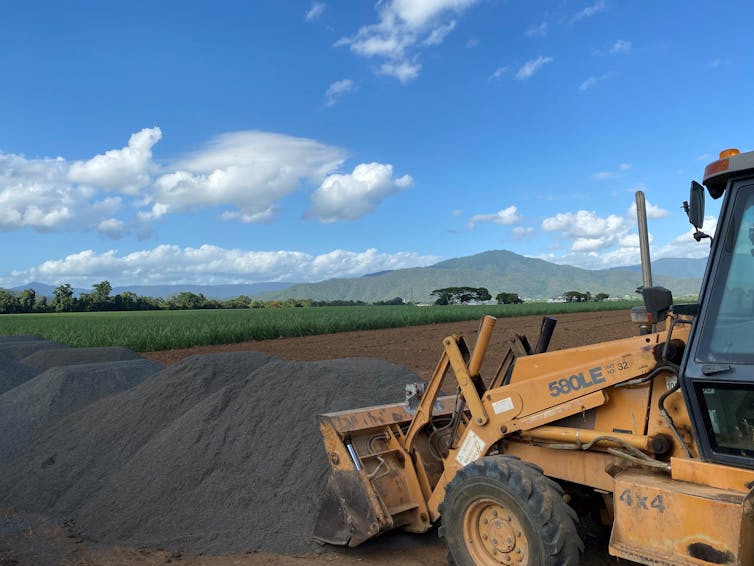Carbon dioxide (CO₂) is naturally removed from the air when it reacts with certain types of rock. We can accelerate this process by crushing suitable rocks and spreading them over agricultural fields. This simple method, known as “enhanced rock weathering”, could vastly increase the rate of CO₂ removal from the atmosphere.
Modelling studies suggest billions of tonnes of CO₂ might be removed annually if crushed rocks were applied to croplands globally. With current energy-related emissions at 37 billion tonnes a year, this means enhanced weathering could contribute in a big way to reaching net zero emissions. A new industry is rapidly emerging to do just that.
But before everyone gets too carried away, it’s crucial to be able to measure how much CO₂ is captured. Both industry and governments will need accurate measurements for effective policy, regulation and reporting.
In our new research, we measured CO₂ capture in a tropical agricultural soil. We found the CO₂ capture rate was low in this soil, despite significant weathering. This means soil type needs to be carefully considered when estimating CO₂ capture rate.
What is rock weathering?
Rock rich in calcium and/or magnesium, such as basalt, can be crushed and spread over the soil to capture CO₂. The rock can be mined for this purpose or obtained as a byproduct from other mines or from gravel making.
In soil, the CO₂ dissolves to form carbonic acid, which is what makes drinks fizzy. This acid can react with the rocks, converting CO₂ into bicarbonate, which traps the carbon in solution.
Bicarbonate can be further converted in the soil and stored as solid carbonate (limestone). Or it can leach into groundwater, then rivers to the sea, where it is stored long-term as dissolved bicarbonate or as carbonate rock.
Rock weathering happens naturally on geological time scales. But for the technology to work in tackling climate change, we need to speed it up.
Existing mining equipment can be used to grind the rock, while agricultural spreaders typically used to distribute lime can spread the crushed rock over the land.
Adding crushed rock in this way can improve soil health and crop production because it neutralises soil acidity, supplies nutrients such as magnesium, calcium and phosphorus, and can help increase soil organic content.
Paul Nelson
How much CO₂ is captured?
In the Midwest United States, potential CO₂ removal rates of up to 2.6 tonnes of CO₂ per hectare per year have been estimated over a four-year period. This was based on applying 50 tonnes of finely crushed basalt per hectare every year. That rate is close to the highest natural rate reported globally, in Java, Indonesia (2.8 tonnes of CO₂ per hectare per year).
But when we applied crushed basalt to a sugarcane field in Australia, over five years at the same rate, we had very different results. Our measurements of bicarbonate and carbonate in soil and water showed very low rates of CO₂ removal.
Overall, the results from laboratory and field trials vary greatly from one study to the next. CO₂ removal estimates range from 0.02 to more than 10 tonnes of CO₂ per hectare. This variation could be due to the nature of the crushed rock and the way it was applied, the climate, soil type, cropping system and the duration of the trial. The figure also depends on the measurement method used.
Are we measuring it right?
We have now shown there can be a large gap between directly measured carbon capture and the amount estimated in other ways. Direct measurement of CO₂ removal through conversion to bicarbonate and carbonate in soil and water can be difficult and costly. So far, this is mainly done in research trials, as we did in our studies.
Other techniques are being developed to estimate in-field CO₂ removal in a way that is easier for monitoring, reporting and verifying large-scale projects. These estimates use a combination of modelling and estimates of weathering rate.
We have shown in a glasshouse study that the discrepancy between measured and estimated CO₂ capture varies a lot between soils. We found this discrepancy is largely driven by soil acidity.
In our recent field trial in an acidic soil, weathering was mostly due to acids that are stronger than carbonic acid. The added rock preferentially reacts with these stronger acids rather than carbonic acid, so rock weathering takes place, but without capturing much CO₂.

James Cook University
Great potential
It’s becoming increasingly clear greenhouse gases will have to be removed from the atmosphere if we are to avoid dangerous climate change. Carbon emissions must be cut, but these cuts won’t be deep enough to achieve net zero emissions by 2050. So carbon removals will need to equal remaining emissions.
Enhanced rock weathering has great potential for CO₂ removal, but we don’t yet have robust ways of measuring its effectiveness. There is a need to better understand the reactions in soil that affect CO₂ removal across different soil types and under different management. We may also need to continue directly measuring carbon capture until we have confidence in more convenient estimates.

The post “Spreading crushed rock over farmland can remove CO₂ from the atmosphere if we do it right” by Paul Nelson, Associate Professor of Soil Science, James Cook University was published on 10/28/2024 by theconversation.com





































Leave a Reply